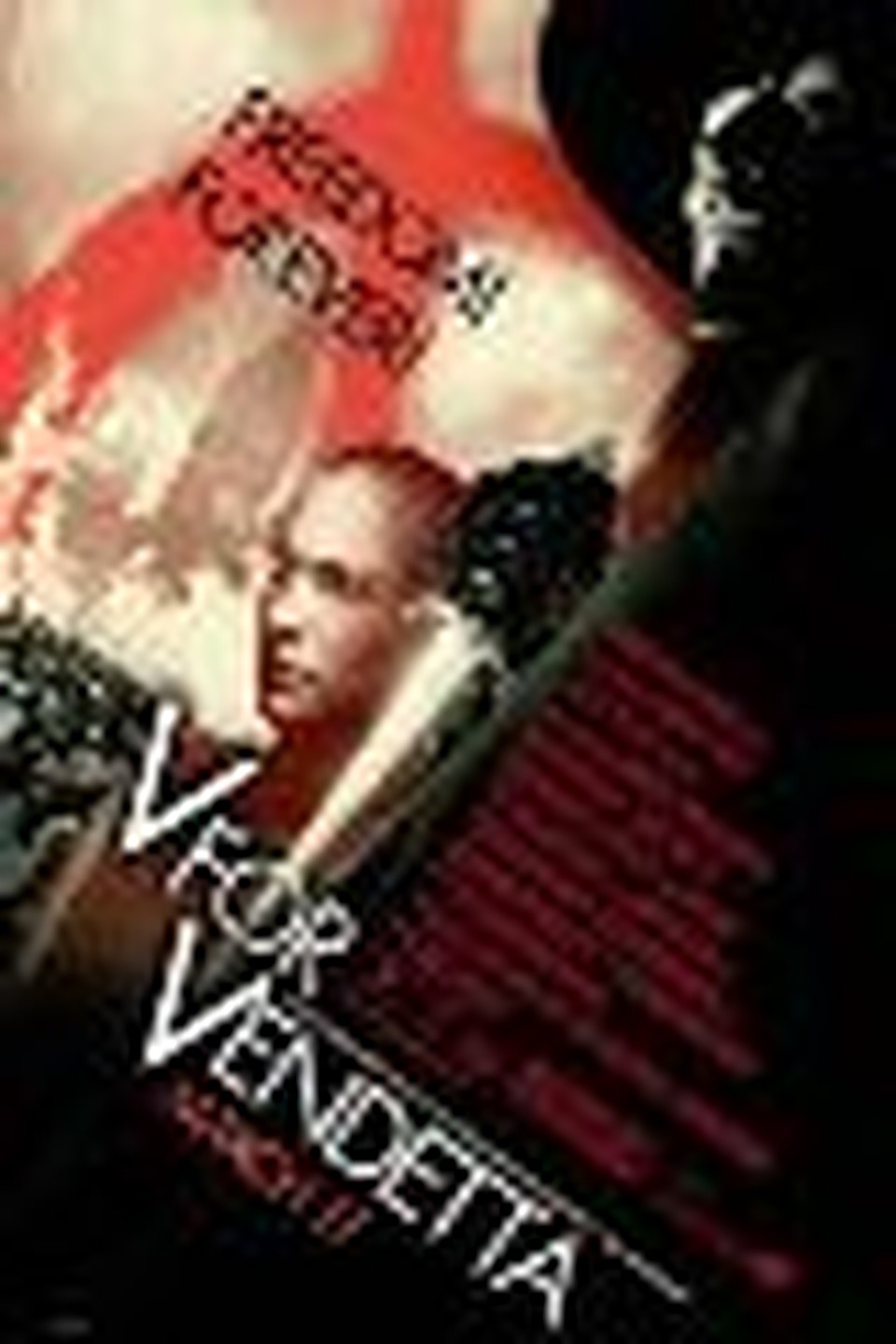Bad Filmmaking, Lack of Credibility Can't Save "Vendetta"

DVD Release Date: August 4, 2006
Theatrical Release Date: March 17, 2006 (wide)
Rating: R (for strong violence and some language)
Genre: Drama
Run Time: 132 min.
Director: James McTeigue
Actors: Natalie Portman, Hugo Weaving, Stephen Rea, Stephen Fry and John Hurt
How’s your recollection of high school English? Need a little brush-up on George Orwell’s “1984”? No? Well, how about just a high school movie, then, with some serious violence? Because “V for Vendetta” is just that – all boring, melodramatic 132 minutes of it.
In this futuristic-yet-current drama, Evey (Natalie Portman) is a coffee-wielding assistant at England’s only television station, which pumps out anti-gay rhetoric, night after night, in the name of “unity and faith,” the mission of the current administration. After being caught out after curfew, Evey is saved from a gang-rape by a strange, knife-wielding man. This hero, who quotes Shakespeare and insists on being called “V” (Hugo Weaving), wears a wig and mask fashioned after Guy Fawkes, the revolutionary who attempted to blow up Parliament in 1605, and whose death is still celebrated each year in England by burning him in effigy.
V coerces Evey to come with him to a rooftop, where he blows up the Old Bailey, London’s famous courthouse. It is, after all, Guy Fawkes Day (November 5) – and V is one very angry guy. He then sneaks into the television station and, after single-handedly shutting everyone out of the broadcast room (and killing a few reporters in the process – oh, well), manages to get on air and broadcast his message about the country’s evil government. V encourages the people to gather outside the Houses of Parliament next year on the same day, wearing Guy Fawkes masks and capes, like him. He will then, he promises, finish the job that Fawkes started four centuries ago.
V’s message resonates with the populace. Whether it’s the fact that people are tired of the government or that the director chose just one suburban family and a few drunken bar flies to represent “the populace” – in repeat cutaways throughout the film – is hard to tell. Either way, V’s got a year to prepare for his mission. He begins by taking Evey hostage, torturing and abusing her and finally convincing her to become his accomplice. As a result, she falls in love with him.
Have I mentioned that this movie is based on a comic book for teenage boys? It’s a “graphic novel” written in the early '80s by a dude named Alan Moore, as a protest against the conservative politics of Margaret Thatcher. And oh, how evil Thatcher was. The script, which was penned by the Wachowski brothers (of “Matrix” fame, including its less-than-lustrous sequels) has been updated with anti-Bush rhetoric. Thank goodness, too. It’s been a long time since we’ve had an anti-Bush movie. I was starting to get a little worried about Hollywood.
With the waif-like Evey as his frightening accomplice, V proceeds to kill every person who harmed or abused him years ago, in what appears to have been human experiments like those conducted by Dr. Joseph Mengele, the ruthless Nazi concentration camp doctor from Auschwitz. (It is during this time that V was severely burned, hence the mask.) V then sets about waiting for Guy Fawkes Day, as the government continues to search for him and Evey.
As I watched this film, I couldn’t help but notice how very much it is aimed at young boys. It’s violent and full of off-color language and superhero gimmicks, with just a hint of romance. Not too much of the icky love stuff, ‘ya know (it barely registers, in fact). But lots of ridiculous scenarios shot on frighteningly few sets, with very few extras, all of which quickly become repetitive.
How has V managed to become so wealthy, for instance, after being so horribly disfigured years ago? He clearly has unlimited resources and lives in a “Phantom of the Opera” style lair, full of banned artwork (like a Buddha statue). He also manages to get around the big city without transportation, and is never caught after curfew. How does he manufacture thousands of wigs and masks, much less get them delivered, in a government-controlled economy? And then there are his killer knife skills, which we’re led to believe are completely self-taught from the old black-and-white “The Count of Monte Cristo” movie.
Are we really expected to swallow this and Portman’s fake British accent, too? Way! In their attempt to skewer Bush, Orwellian style, the Wachowskis threw all credibility out the window. No wonder Moore, the book’s author, reportedly called the film “rubbish” and refused to have his name appear in the credits.
The film’s primary message is that homosexuality is acceptable. Gays are portrayed as sophisticated yet innocent, and routinely subjected to rejection from family and friends, as well as outright persecution. This message appears, perhaps not surprisingly, at a time when many states have succeeded in banning gay marriage in the U.S., and it’s extremely obvious throughout the film. In the busy city of London, for example, only homosexuals are beaten, jailed and murdered – not people of other faiths or races. Several scenes with gay characters underscore this message, including an extended montage (complete with two women snuggling and kissing) and a voiceover from a young woman who discovered she was gay as an adolescent, was kicked out of her house and eventually sentenced to death by the government. As Evey reads the woman’s letter describing these atrocities, she weeps in sympathy.
The second, somewhat less obvious message, is an anti-Christian one. The government’s symbol in the film is a red banner in the style of the Third Reich, with a red Patriarchal Cross, also known as the Archiepiscopal Cross (a beam with two cross beams). A bishop is portrayed as a sick pedophile. And, throughout the film, we hear about the need for “unity through faith,” along with faith-based hate rhetoric.
The film does explore contemporary issues, which is a good thing. In particular, it asks whether vigilante justice is justified in the face of a fascist, totalitarian state. And, while I would stridently disagree that we currently have such a state in this country, I certainly believe that rebellion, especially against a morally corrupt and ungodly government, is necessary at times.
“V for Vendetta” is not portraying a civil rights march, however, as much as the filmmakers would have us believe it is. It’s about a deranged individual who is seeking personal revenge and who, having achieved that revenge through violent acts, goes on to destroy a treasured, historical landmark, complete with fireworks, as a symbol of his rebellion and his narcissism. That’s not civil disobedience; that’s terrorism.
What’s really scary is that the film communicates that these acts are not only acceptable but even to be emulated, if necessary. When the filmmakers compare these terrorist acts to the founding of our country (in one of the barebones DVD “extras”), it only underscores the absurdity of their thinking. In the end, “V for Vendetta” has a lot more problems than credibility, however. Simply put, it’s bad filmmaking. And, surprisingly, it’s also quite boring, despite the pyrotechnics.
DVD EXTRAS:
- Freedom! Forever! Making V for Vendetta
- Scene Selection
- Subtitles
AUDIENCE: Adults only
CAUTIONS:
- Drugs/Alcohol: Various scenes with alcohol.
- Language/Profanity: A dozen or so obscenities, some strong, and several profanities.
- Sexual Content/Nudity: Female character is seen in undergarments; female character dons child-like sex garb and entices pedophile bishop, who engages in sex talk with her; various arguments in favor of homosexuality offered through voice-overs; two women hold hands, cuddle and passionately kiss.
- Violence: Extremely graphic. Throughout film, people are slashed, stabbed, shot and beaten, with copious amounts of blood (often shown in slow motion).
Originally published August 07, 2006.







